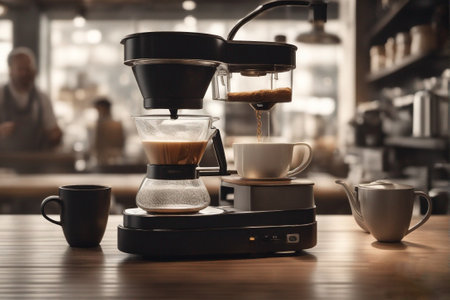Understanding Pre-Owned Coffee Equipment in the UK
If you’ve recently snapped up a second-hand coffee machine or grinder in Britain, congratulations: you’re entering a world where history and innovation blend as seamlessly as a perfect flat white. The UK’s pre-owned coffee market is a treasure trove of both classic and contemporary gear, ranging from well-loved Gaggia espresso machines to iconic British-built filter brewers and sturdy commercial grinders. While many Brits have an eye for vintage charm, it’s essential to note that older models often come with their quirks—like imperial fittings or unique electrical plugs—reflecting the rich heritage of British engineering. When purchasing pre-owned equipment here, pay attention to tell-tale signs of hard water use (limescale is a frequent culprit in the UK), check for safety certifications like the CE mark, and always enquire about the machine’s service history. Whether you’re scouring Gumtree, car boot sales, or specialist second-hand retailers, knowing what to look for ensures your next cup is brewed with both style and confidence.
2. Initial Cleaning and Hygiene Essentials
When you’ve just picked up a pre-owned coffee machine from somewhere in Britain—be it a vintage espresso maker from a car boot sale in Brighton or a sturdy filter brewer from a charity shop in Leeds—hygiene is paramount. Giving your new-to-you kit an initial thorough clean not only ensures great-tasting coffee but also aligns with UK health standards, keeping any lingering bacteria or old coffee oils at bay. Here’s your step-by-step guide for getting started:
Step 1: Gather Recommended Cleaning Supplies
| Item | Recommended Brand/Type (UK) | Purpose |
|---|---|---|
| Mild Washing-up Liquid | Fairy, Ecover | General cleaning of external surfaces & removable parts |
| Descaler | Ecozone, Oust | Limescale removal (essential for hard UK water areas) |
| Coffee Machine Cleaning Tablets/Powder | Cafiza, Puly Caff | Internal cleaning of group heads and brewing chambers |
| Microfibre Cloths | – | Wiping down surfaces without leaving residue |
| Bottle Brush or Group Head Brush | – | Scrubbing difficult-to-reach nooks and crannies |
| Food-Safe Sanitiser Spray | D10, Dettol Food Surface Cleaner | Final sanitation of all contact areas |
Step 2: External Clean and Inspection
a. Unplug the machine and dismantle all removable parts—water tanks, drip trays, portafilters, baskets.
b. Soak these parts in warm water mixed with mild washing-up liquid for at least 15 minutes.
c. Scrub gently with a soft brush to remove built-up grime or stubborn stains.
d. Rinse thoroughly with fresh tap water (Britain’s tap water is safe and ideal for rinsing).
e. Wipe the exterior with a damp microfibre cloth, paying attention to knobs, handles and display screens.
Step 3: Internal Descaling (Especially Important in the UK!)
Limescale builds up quickly across the UK due to hard water. To tackle this:
- Add a recommended descaler solution to the water tank as per product instructions.
- Run the cleaning cycle or “brew” hot water through the system until the tank is empty.
- If your model allows, repeat with plain water to flush out any chemical residue—always check your manual!
- If applicable, use specialised tablets or powder for group heads following manufacturer’s guidance.
Sensible British Tips:
- Avoid vinegar solutions as they may void warranties and leave lingering smells—stick to UK-certified products.
- If you’re unsure about compatibility with your machine, consult the manufacturer or trusted local baristas (your neighbourhood indie coffee shop will likely have advice!).
- Kettles and coffee makers bought second-hand should be descaled even if they look clean—the hidden build-up can affect taste and performance.
Your Kit Is Now Ready for Its Next Chapter!
This meticulous first clean not only preserves that quintessentially British brew quality but also gives you peace of mind. With everything sparkling and sanitised, you’re set to move on to regular maintenance—and more importantly, enjoy that first perfect cuppa from your newly acquired kit.

3. Routine Maintenance for Longevity
To ensure your pre-owned coffee equipment continues to perform at its best, regular maintenance is absolutely essential—a lesson well-learned from the meticulous routines of British cafés. Start by establishing a weekly cleaning schedule, as even the most robust machines found in bustling London coffee houses need a bit of TLC. Descaling is particularly important in the UK, where hard water can quickly lead to troublesome limescale build-up. Use a reputable descaling solution and follow the manufacturer’s guidelines; this not only protects your boiler but also helps maintain those crisp, clean espresso notes beloved by British coffee aficionados.
Best Practices Inspired by British Café Culture
Café owners across Britain swear by daily wipe-downs of all external surfaces with a damp, lint-free cloth, ensuring no residue or milk splashes linger. For bean grinders, remove and brush out the burrs every fortnight to keep grinds consistent—essential for that perfect flat white or cappuccino. Don’t forget to empty drip trays and clean portafilters regularly to prevent any unpleasant odours or blockages.
Replacing Parts: A Practical Approach
Just as you’d swap out a worn-out kettle or toaster, replacing small parts like group gaskets, shower screens, and rubber seals every six months is key to reliable brewing. Many UK baristas keep spare kits on hand so there’s never a disruption during the morning rush. Consult your equipment’s manual or pop into a local supplier in Soho or Shoreditch for genuine replacements.
Keeping It Ticking Over
By integrating these routine practices into your home or business set-up, you’ll mirror the standards upheld in Britain’s finest independent cafés. Not only does this prolong the life of your pre-owned kit, but it also ensures every cup poured is worthy of a proper British brew—consistently smooth, rich, and free from faults.
4. Troubleshooting Common Issues
When welcoming pre-owned coffee equipment into your British kitchen or café, it’s only natural to encounter the odd hiccup. Spotting and fixing these typical troubles needn’t be a daunting task—especially with a practical, British approach. Below, you’ll find a handy guide to identifying and remedying the most common issues that arise with second-hand machines, so you can keep the brews flowing without a hitch.
How to Spot Common Problems
| Issue | Symptoms | Likely Causes |
|---|---|---|
| No Power | Machine won’t switch on, lights not working | Loose plug, blown fuse, faulty power switch |
| Poor Extraction | Weak or bitter coffee, watery shots | Clogged group head, old beans, incorrect grind size |
| Leaking Water | Puddles beneath machine, dripping from seams | Worn gaskets, cracked hoses or seals |
| Low Pressure/Steam | Poor frothing or slow water flow | Limescale build-up, blocked steam wand or valves |
| Strange Noises | Loud rattling or grinding sounds during operation | Loose components, debris in pump or grinder |
Troubleshooting Steps – The British Way
No Power? Start with the Obvious!
If your machine refuses to wake up, don’t panic. First, check the plug is firmly in the socket—a simple step often overlooked on a busy morning. Next, inspect your fuse (most UK plugs have them). If blown, replace it with one of matching rating. Still no luck? The power switch or internal wiring may require attention; when in doubt, ring up a local appliance repair chap.
Poor Extraction and Taste Troubles
If your flat white tastes off or your espresso pulls weakly, start by giving the group head a good clean—residue and old grounds are frequent culprits. Always use fresh beans and adjust your grinder for consistency; remember, British water can be hard, so regular descaling is essential for optimal flavour. A quick backflush with specialised cleaning powder works wonders too.
Water Leaks – Keep Calm and Tighten On!
A bit of leakage is common in older kit. Check all visible hoses and connections for cracks or looseness. Many gaskets and seals are easily replaced—just pop down to your local hardware shop or order replacements online. For stubborn leaks from hard-to-reach spots, consult a professional before things get messy.
Low Steam or Pressure Issues?
If your cappuccino foam lacks its usual vigour, limescale may be at fault—especially in regions like London or Manchester where hard water reigns supreme. Run a descaling solution through the system per manufacturer guidelines. Also, remove and soak steam wands in warm vinegar to clear any blockages.
Mysterious Rattles and Clunks?
Bizarre noises often stem from loose screws or trapped debris. Unplug the machine and give it a gentle once-over—tighten any visible screws and look for stray beans wedged near the grinder. If unsure about opening panels yourself, best leave it to someone handy down at your local repair shop.
Quick Reference Table: British Solutions for Common Coffee Equipment Faults
| Problem Area | DIY Fixes | When to Call an Expert? |
|---|---|---|
| Power Supply/Fuse Issues | Check plug/fuse; replace if necessary | If issues persist after fuse change |
| Limescale Build-Up | Descale regularly with UK-appropriate solutions (citric acid/vinegar) | If pipes/boiler remain blocked after treatment |
| Leaks/Gasket Wear | Tighten connections; replace gaskets/seals available at most DIY shops | If leak source is internal or inaccessible |
| Grinder Malfunction/Blockage | Clean out hopper/burrs; check for stones or foreign objects | If grinding mechanism seizes up or makes unusual noises |
Tackling these typical issues with a measured dose of British resourcefulness ensures your cherished pre-owned coffee equipment stays in tip-top shape—ready to serve up brilliant brews day after day.
5. Finding Parts and Reliable Repair Services in Britain
When it comes to keeping your pre-owned coffee equipment in tip-top condition, sourcing trustworthy spare parts and skilled repair services is key. Across the UK, you’ll find a rich network of suppliers and specialists who understand the quirks of everything from classic espresso machines to niche filter brewers.
Where to Source Reputable Spares
Start by checking with established British retailers like Coffee Hit or Bella Barista, both known for their wide selection of genuine components. If your machine is a popular make such as Sage or Gaggia, most high-street appliance shops and online outlets will stock essentials—think seals, group head gaskets, or replacement baskets. For more obscure or vintage models, reach out to dedicated forums like UK Coffee Forums where enthusiasts often exchange leads on hard-to-find parts and trusted sellers.
Tapping Into Local Service Networks
The UK’s vibrant coffee culture means there are plenty of independent engineers with years of hands-on experience. Many towns have at least one local service centre catering to domestic and commercial users alike. Look for repairers who are members of the Beverage Standards Association (BSA) or recommended by respected roasteries; these professionals have a reputation for quality and reliability.
Specialist Repairers Across the UK
If you’re dealing with complex issues or rare equipment, it pays to seek out specialist workshops such as Espresso Solutions (Surrey) or The Espresso Shop (Glasgow). These experts offer mail-in repairs and can even provide remote troubleshooting advice. Don’t hesitate to ask for references or testimonials—British repairers take pride in their craft and are usually happy to share success stories from fellow home baristas.
By connecting with reputable sources for spares and tapping into the deep well of local expertise, you ensure your freshly acquired coffee kit keeps delivering that perfect cup—whether you’re brewing in Bristol, Brighton, or beyond.
6. Sustainable Coffee Equipment Care in the UK
If you’ve recently bought pre-owned coffee equipment in Britain, embracing sustainable maintenance not only honours the nation’s eco-conscious values but also ensures your gear lasts for many more cups to come. Here are some practical, eco-friendly tips tailored for the UK that reflect the local commitment to sustainability and the circular economy.
Choose Green Cleaning Solutions
Swap out harsh chemicals for natural alternatives like distilled vinegar, baking soda, or citric acid—readily available from British supermarkets or local zero-waste shops. These options effectively descale and disinfect without harming your equipment or the environment.
Reduce Waste with Reusable Materials
Opt for reusable cloths instead of paper towels and invest in long-lasting cleaning brushes. Many independent shops across the UK offer sustainable cleaning products; supporting them strengthens local economies and reduces your carbon footprint.
Repair Over Replace
Britain’s vibrant repair culture is alive and well, with Repair Cafés and community workshops thriving nationwide. Before discarding a faulty part, consult local repair groups or online forums—often, a simple fix can save both money and resources.
Source Second-Hand Spares
If replacement parts are needed, search for second-hand spares through British platforms like eBay UK, Gumtree, or specialist coffee forums. This keeps useful items in circulation and prevents unnecessary waste.
Save Energy Where Possible
Switch off your coffee machines when not in use and unplug grinders to conserve energy. Many British homes now use renewable electricity tariffs—pairing this with mindful appliance usage further reduces your environmental impact.
Recycle Responsibly
When a component reaches the end of its life, check with your local council about small appliance recycling schemes. The UK’s dedication to responsible disposal ensures valuable materials are recovered and kept out of landfill.
Cherish the Circular Economy
Caring for pre-owned coffee gear is about more than just maintenance—it’s about participating in a broader movement towards reuse, repair, and conscious consumption. By choosing sustainable care methods, you’re brewing a better future that aligns perfectly with British values of stewardship and style.


